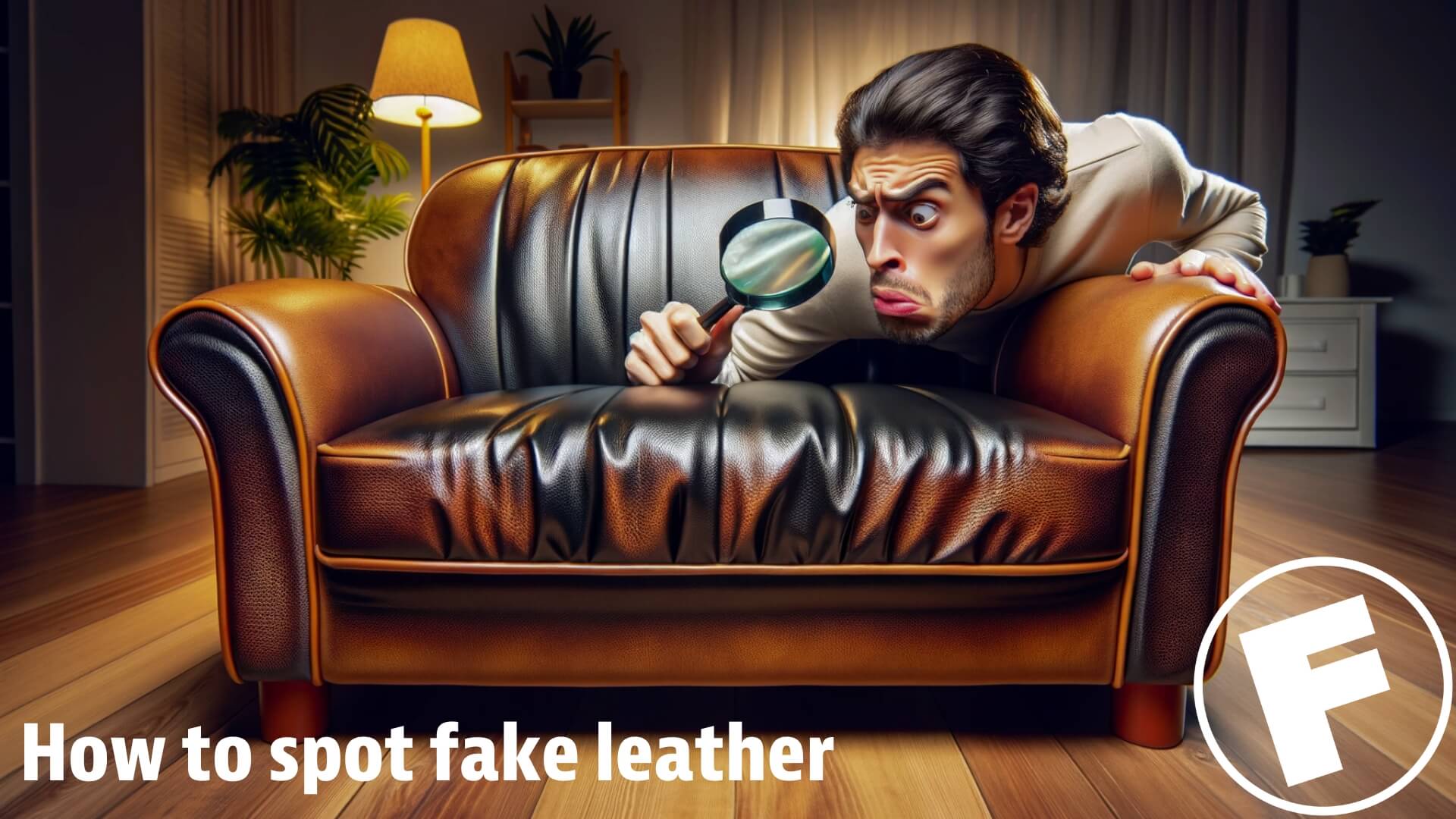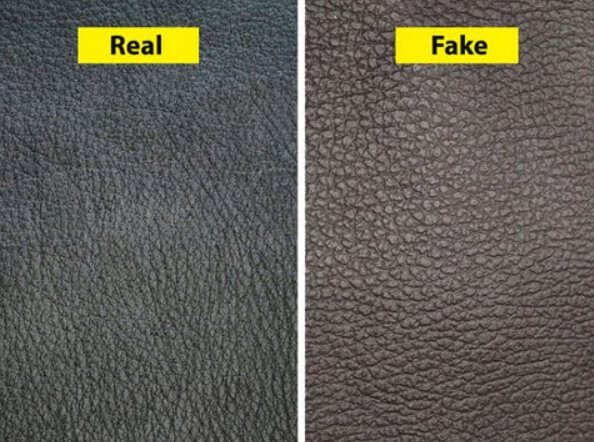How to spot fake leather
Spotting fake leather–also known as faux leather or synthetic leather–can be challenging because manufacturers have become increasingly skilled at mimicking the look and texture of real leather.
However, there are several methods and visual cues that can help you identify fake leather. Here’s how to tell the difference between fake leather and authentic leather. Check it out!

Understanding fake leather
With the rise of synthetic materials and the increasing sophistication of faux leather products, distinguishing the real thing from its artificial counterparts has become a crucial skill for both consumers and professionals.
Understanding the nuances between genuine and artificial leather is not just a matter of aesthetics or preference, but also one of ethical consumption, environmental impact, and getting the value you pay for.
Whether it’s the feel of a fine leather jacket, the sophistication of a genuine leather handbag, or the comfort of leather upholstery, leather stands out as timeless and impressive.
Imitation leather is made to take advantage of precisely that sentiment. Brands know consumers want to look posh, but don’t like the hefty price tag. But the thing is, real full-grain leather, top-grain leather, bonded leather or any other true type is exceedingly better in quality, feel, and longevity.
How fake leather products are manufactured
No animal hide, animal skin, or natural leather involved here.
Faux leather is a purely man-made material—and here’s a quick breakdown on how it’s made:
- Base Material Preparation: The foundation of faux leather is a base material, often a polyester knit or a cotton-poly blend. This base provides the structural support for the coating that will be applied later.
- PVC or Polyurethane Application: The primary materials used to create the leather-like finish are PVC (Polyvinyl Chloride) or PU (Polyurethane). PVC provides a texture closer to patent leather, while PU can be made to resemble softer, more pliable leathers.
- For PVC-based faux leather, the PVC is mixed with plasticizers and other additives, then applied to the base material.
- For PU-based faux leather, the PU is directly coated onto the base fabric in layers. PU is more flexible and breathable compared to PVC.
- Texturing and Coloring: After the primary material is applied, the fabric is textured to mimic the look of genuine leather. This can be done through various methods, such as embossing or using rollers. The material is also dyed to achieve the desired color and may undergo additional processes for effects like a matte or glossy finish.
- Finishing Treatments: Additional treatments might be applied to give the faux leather certain properties, such as water resistance, stain resistance, or additional durability.
- Curing and Drying: The final step involves curing and drying the material to set the texture, color, and finish. This can be done through heat treatment or air drying.
So as you can see, the materials and processes for making fake leather vastly differ from the traditional, quality leather-making processes. Now let’s look at some ways you can detect faux leather.
How to identify fake leather
Here are some tried-and-true methods for distinguishing fake products from the real deal.

The observable difference in appearance between real and fake leather.
- Check the price and source:
- One of the first indicators of fake leather is the price. Real leather tends to be more expensive than synthetic alternatives.
- Be cautious when buying leather goods from suspiciously cheap or unverified sources, especially if the price seems too good to be true.
- Examine the texture:
- Real leather has a unique texture with natural imperfections like pores, wrinkles, and grain patterns. These are often absent or less pronounced in fake leather.
- Run your fingers over the surface to feel the texture. Real leather will feel soft and slightly warm, while fake leather may feel cooler and smoother.
- Check the edges and seams:
- Look closely at the edges and seams of the item. Genuine leather will have rough or raw edges, while fake leather may have perfectly cut and finished edges.
- Inspect the pores:
- If the leather item has visible pores or grain patterns, examine them closely. Real leather pores are irregular in size and spacing, while fake leather often has a more uniform pattern.
- Magnification tools like a magnifying glass or smartphone camera can help you see these details more clearly.
- Smell the material:
- Real leather has a distinct, pleasant, and earthy smell, often described as a mix of wood and animal odor. Faux leather may have a chemical or plastic-like odor.
- If you’re familiar with the smell of real leather, a quick sniff can be a good indicator.
- Perform the water drop test:
- This test helps you check the absorbency of the material. Real leather is porous and will absorb a small amount of water, while fake leather will not.
- Place a few drops of water on an inconspicuous area of the material. Real leather will darken as it absorbs the water, while fake leather will remain unchanged.
- Check for peeling or flaking:
- Fake leather tends to peel or crack over time, revealing a fabric or synthetic base layer.
- Inspect the surface for any signs of peeling or flaking, especially in high-wear areas like corners and edges.
- Look for a fabric backing:
- Flip the item over or inspect the lining. Real leather typically does not have a fabric backing, while fake leather often does.
- If you see a fabric layer, it’s likely faux leather.
- Pay attention to labels and tags:
- Manufacturers of genuine leather goods often label their products as “genuine leather” or specify the type of leather used.
- Be cautious if there are no such labels or if the labeling appears generic.
- Seek professional advice:
- If you’re unsure about the authenticity of a leather item, consider consulting an expert or a trusted leather professional for their opinion. Fibrenew to the rescue!
- By combining these methods and paying attention to detail, you can become more skilled at identifying fake leather and make informed purchasing decisions.
Keep in mind that some high-quality synthetic leather materials can be difficult to distinguish from genuine leather, so using multiple methods is often the most reliable approach.
Consult a Fibrenew expert for all your leather questions and needs
We’re always here to give you peace of mind when it comes to all things leather.
Get in touch with your local Fibrenew operator for any questions.
And if you’re passionate about leather, maybe a career in leather repair and restoration is the path for you. Check our free Franchise Information Report for everything you need to know.
Until next time!
How to spot fake leather FAQ
What is the main difference between genuine and fake leather? The main difference lies in the material origin. Genuine leather is made from animal hides, such as cow, sheep, or goat, while fake leather, also known as synthetic leather, is made from plastic materials like polyurethane or PVC. Genuine leather has unique textures and imperfections, whereas fake leather often has a more uniform pattern and texture. Can you identify fake leather by touch? Yes, often you can. Genuine leather typically feels soft, flexible, and can vary in texture. Fake leather usually feels smooth, plastic-like, and less natural. However, high-quality fake leather can mimic the feel of real leather quite closely. Is there a smell difference between genuine and fake leather? Absolutely. Genuine leather has a distinct, rich smell that synthetic materials cannot replicate accurately. Fake leather often has a chemical or plastic smell due to the materials used in its manufacturing. Does genuine leather have any unique visual characteristics? Yes, genuine leather usually shows natural imperfections like creases, wrinkles, and slight variations in color. The pores in real leather may be uneven and have an inconsistent pattern. In contrast, fake leather often has a very uniform, consistent pore pattern. How does water affect genuine leather compared to fake leather? Genuine leather absorbs water and can become darker where the water was absorbed. Fake leather, made from plastic, usually repels water and won’t absorb it. Can price be an indicator of real versus fake leather? Generally, genuine leather tends to be more expensive due to its durability and the more complex manufacturing process. However, price shouldn’t be the only indicator, as some fake leathers can be pricey, and there are also affordable genuine leather products. Are there any specific tests I can perform to check for fake leather? Yes, one common method is the heat test. Genuine leather will not melt when exposed to heat, whereas synthetic leather may shrivel or melt. However, this test can damage the material, so it should be done cautiously and as a last resort. Is labeling a reliable way to determine if a product is made of real leather? Labels can be helpful, as genuine leather products are often marked with labels like “Genuine Leather”, “Full-Grain”, or “Top-Grain”. However, be cautious, as labels can be misleading or false. It’s best to use labeling in conjunction with other methods of identification. Can the flexibility and aging of the material indicate if it’s genuine leather? Yes, genuine leather becomes more supple and develops a patina over time, known as aging gracefully. Fake leather tends to crack and peel over time without developing the same rich patina or natural aging process. Is there a difference in breathability between genuine and fake leather? Genuine leather is more breathable compared to fake leather. This is due to the natural pores in real leather, which allow air to pass through, making it more comfortable, especially in clothing and footwear. Can the weight of the material help in identifying fake leather? Genuine leather typically weighs more than fake leather. The weight difference is due to the denser fibers in real leather, as opposed to the lighter, synthetic materials used in fake leather. Are there environmental considerations in identifying fake leather? Yes, genuine leather usually has a lower environmental impact compared to synthetic alternatives, which are petroleum-based and less biodegradable. Ethical considerations, such as the source of the leather, also play a role in this distinction.
